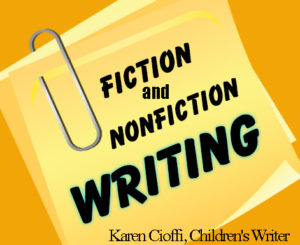 Writing fiction and writing nonfiction have some distinct similarities and differences.
Writing fiction and writing nonfiction have some distinct similarities and differences.
But, before we get into that, let’s find out the definitions of fiction and nonfiction:
Fiction: According to Merriam-Webster.com, fiction is “something invented by the imagination or feigned, specifically an invented story; the action of feigning or of creating with the imagination.”
Nonfiction: Merriam-Webster’s definition of nonfiction is “literature or cinema that is not fictional.” According to Allwords.com, nonfiction is “written works intended to give facts, or true accounts of real things and events.”
Now on to the similarities and differences.
Writing Fiction and Writing Nonfiction Similarities:
1. You need to start with an idea.
2. You can write about almost anything.
3. You need ‘good’ writing skills (at least you should have good writing skills).
4. You need to have a beginning, middle, and end to the story.
5. You need to have an engaging, entertaining, informative, or interesting story.
6. You can work from an outline or you can seat-of-the-pants it.
7. You may need to do research.
8. You need to revise, proof, and edit your work.
Writing Fiction and Writing Nonfiction: Two Significant Differences
1. If you are writing nonfiction, you must stick to truths and facts, a nickel is a nickel, the sun rises in the east and sets in the west, two plus two equals four, and 10 times 10 equals 100. While there may be some grey areas, such as perspective, circumstances, or circumstantial evidence leading up to a fact based story, the fact is always the fact.
As an example: According to The World’s Easiest Astronomy Book (Year Published) by Hiroshi Nakagawa, “The speed of light is 300,000 km (186,000 miles) per second, meaning that light could circle the Earth seven and a half times in a single second. Even at this incredible speed it still takes light from the Sun eight minutes to reach the Earth. That means that when we see the Sun, what we actually see is the Sun from 8 minutes ago” (p. 13).
These are facts. If you’re writing a nonfiction story about astronomy, these facts can’t change. Your story is limited to truths and facts. This is not to say the story can’t be amazingly interesting and engaging. The children’s middle-grade nonfiction book “The World’s Easiest Astronomy Book” can certainly spark a child’s imagination and interest in astronomy.
On the other hand, if you’re writing fiction, your imagination is your only limit. You don’t have to stay within the confines of what is known, what is truth. This offers a certain freedom.
If you want the sun to be ‘blood red,’ then it’s blood red. If you want to be able to travel to the moon in the blink of the eye, then it’s so. If you say a character can ‘walk through walls’ or is invisible, then he can and is. You can create new worlds, new beings . . . again, your imagination is your only limit.
2. In writing nonfiction you will most likely need to provide reference sources and add quotes to your story. This is to establish the reliability and credibility of your story.
In this case, you will need to reference the source of the quote.
If you notice above, in regard to the facts about the speed of light, I included the name of the book and the author along with the page number. These references substantiate the facts within your article. This makes your nonfiction story credible.
This is not the case with writing fiction. With fiction, you will NOT need information references for credibility. Although, it’s important to realize that your fiction story will become its own truth and you will need to stay within the confines of the particular story you create.
The reason for this: every story needs structure and intent; it needs to move forward to a satisfying ending. If you move off in too many directions, you’ll lose your intent and most probably your reader. To ensure the structure and your intent remains intact, you’ll need to stay within the confines of the story you create.
While the similarities between writing fiction and writing nonfiction seem to outweigh the differences, the differences are significant enough for most writers to prefer one genre over the other.
Reference Note:
In the quote used above, the publisher of the book usually has a copyright date that would be included in the reference. This book does not have one.
MORE ON WRITING FOR CHILDREN
Writing for Children – Character Believability and Conflict
What Makes a Good Story? Plot Driven vs. Character Driven
Editing a Children’s Book – 10 Tips Checklist for Authors
![]() Let me take a look at it. I’m a working children’s ghostwriter, rewriter, and editor. I can turn your story into a publishable story you’ll be proud to be author of.
Let me take a look at it. I’m a working children’s ghostwriter, rewriter, and editor. I can turn your story into a publishable story you’ll be proud to be author of.
Shoot me an email at: kcioffiventrice@gmail.com (please put ‘Children’s Writing Help’ in the Subject line)
This article was originally published by Karen Cioffi at:
http://www.writersonthemove.com/2011/12/writing-fiction-and-writing-nonfiction.html